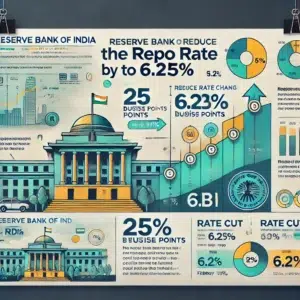RBI to Cut Repo Rate in February Amid Slower Growth and Inflation
The Reserve Bank of India (RBI) plans to reduce the repo rate by 25 basis points to 6.25% in February 2025. Economists predict this rate cut will help slow the economy and reduce inflation.
 India’s Economic Slowdown
India’s Economic Slowdown
India’s economy is facing a slowdown. In the July-September quarter, GDP growth was just 5.4%, much lower than last year’s 8.2%. The budget, released on February 1, 2025, is unlikely to boost infrastructure spending. Therefore, the RBI must act to stabilize the economy.
Inflation is still above the RBI’s target of 4%. The Indian rupee has also weakened by 3% against the US dollar in 2024. Despite selling billions in reserves, the RBI struggles to stabilize the currency.
What the Rate Cut Means
The rate cut will likely help, but it won’t immediately boost growth. According to Kunal Kundu, an economist at Societe Generale, “A rate cut alone won’t lead to a full recovery. Both monetary and fiscal policies must work together.”
Most economists expect the repo rate to fall to 6.25%. However, some believe it will stay at 6.50%. Inflation remains a concern. Rahul Bajoria, an economist at Bank of America, explains that exchange rate pressure limits the RBI’s room to maneuver.
India’s Outlook for Growth and Inflation
The economic outlook for India is moderately positive. GDP is expected to grow by 6.4% for the fiscal year ending in March 2025. However, the growth will still be below the 8% needed to create enough jobs for the growing population.
Inflation is expected to stay above the RBI’s 2-6% target range until mid-2025. This will make it hard for the RBI to balance growth and price stability.
Key Takeaways:
- RBI plans to cut the repo rate to 6.25% in February 2025.
- India’s GDP grew just 5.4% in the July-September quarter, lower than last year’s 8.2%.
- Inflation remains above the RBI’s target, and the rupee faces pressure.
- Economists forecast GDP growth of 6.4% for the fiscal year ending in March 2025.
- A coordinated approach between monetary and fiscal policies is crucial for recovery
 India’s Economic Slowdown
India’s Economic Slowdown